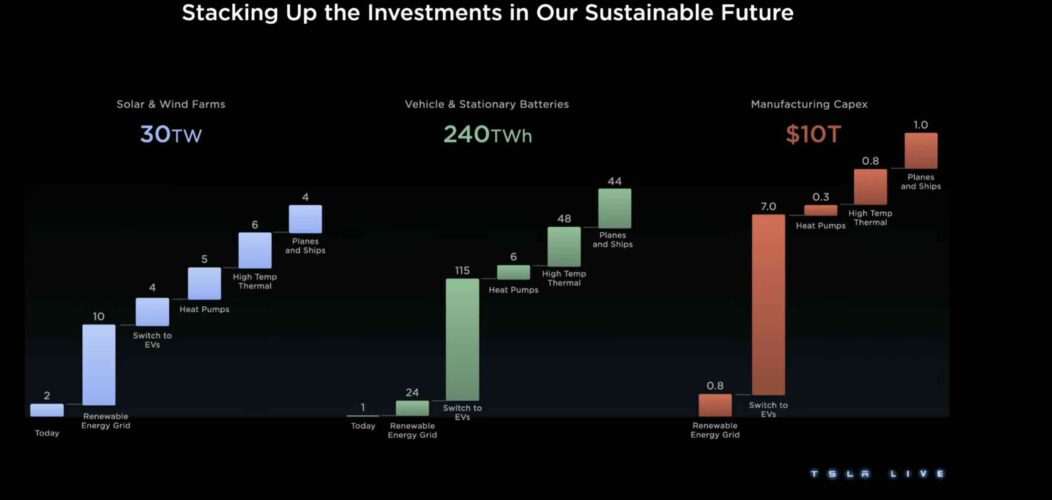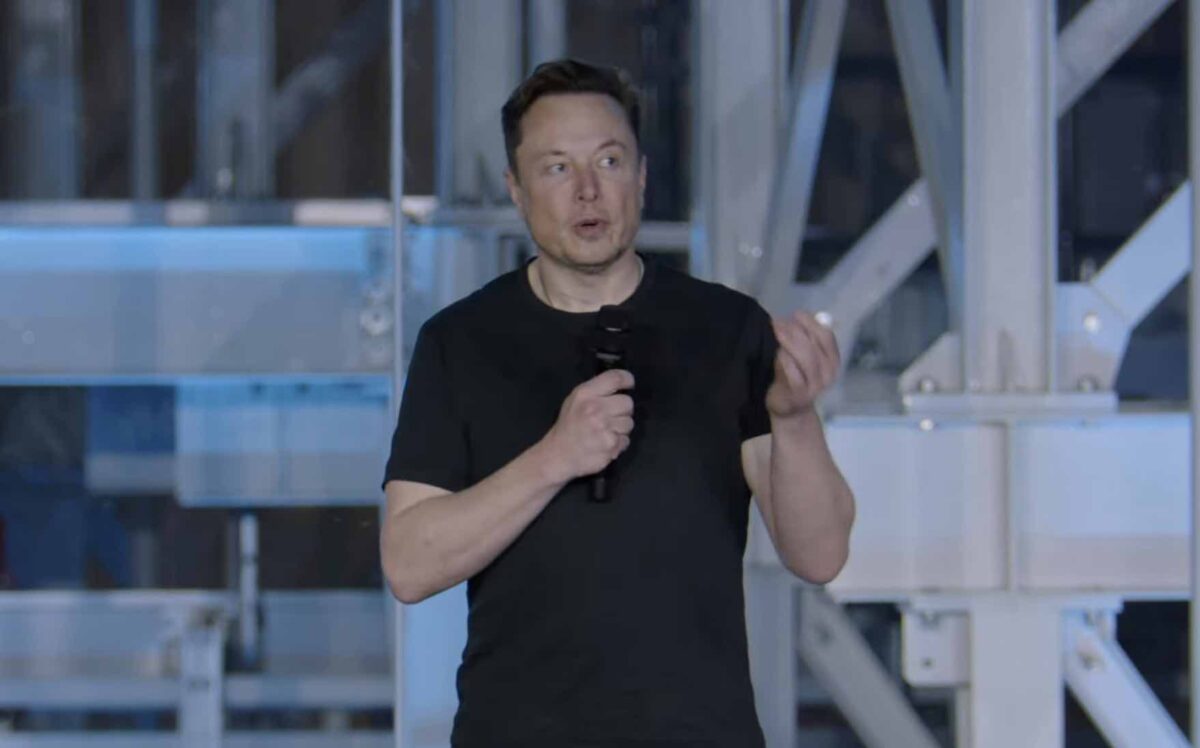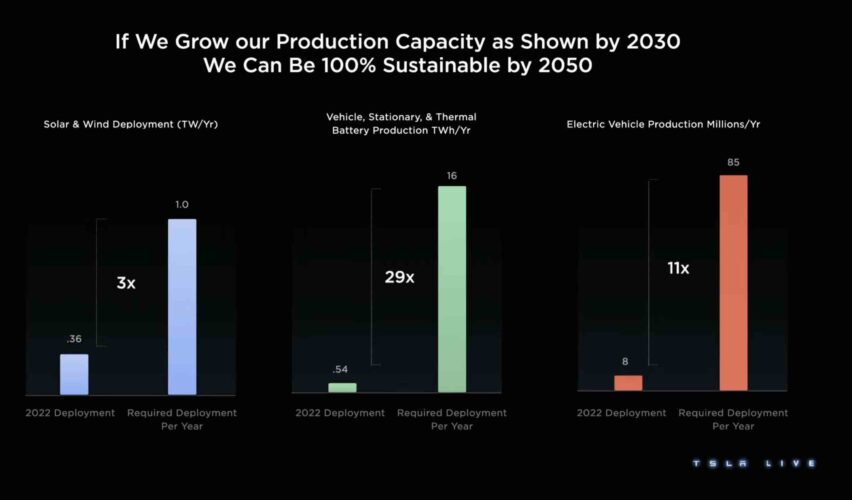Tesla boss Elon Musk has outlined his vision for an efficient, all electric global economy that kicks out fossil fuels and brings an end to the combustion economy – within our lifetime and at lower cost to what we pay now.
At the EV and storage company’s latest Investor Day, Musk says there is a clear path to a fully sustainable Earth “with abundance”, and which can host much more than eight billion humans.
“I’m shocked and surprised by how few people realise this,” Musk said, before going on to dump on a few common myths perpetuated by the fossil fuel industry.
Musk says having 30 terawatts of wind and solar to power the global economy would require little space, just 0.2 per cent of the Earth’s surface, and would result in less mineral extraction, not more. He said there is no issue with lithium supplies or other key minerals.
Musk in particular pointed to the huge efficiency gains of an electric economy over combustion engines, so efficient that the world would need just half the power it produces with “dirty and wasteful” fossil fuels. He said the electric future would cost just 60 per cent of the cost of investing in fossil fuels.

The calculations released by Tesla at its Investor Day involve 30 terawatts (30,000 gigawatts) of wind and solar farms, with one third of these needed to supply a completely renewable grid, and the rest to support electric cars, heat pumps, heat and planes and shipping.
Another 240 terrawatt hours of storage was needed. Just 24TWh would be stationary storage for the grid, with most of this storage going to EVs which can also supply the grid.
Another $US10 trillion would be needed to invest in manufacturing capacity, mostly in the switch to EVs, but also in the renewable grid, and the other parts of the electric economy.
“What we want to convey is a message of hope and optimism … and optimism that is based on actual physics, and real calculations,” Musk said. “It’s not wishful thinking. We can and will move to a sustainable energy economy and we will do so in your lifetime.”
To illustrate the scale and speed of what needs to be done, Musk and his team revealed this chart that shows only a three-fold rollout of wind and solar is needed per year, although the rate of increase in storage (29 times) and in EV production (11 times) is much greater.
“We’re talking about only a 3x growth rate and solar wind deployment,” said Drew Baglino, the head of powertrain and energy engineering at Tesla.
“Solar is already growing at a breakneck pace as is, and this gap is going to be closed really quickly.
“When we look at the electric vehicles, they have to grow 11x. Well, they grew 60% year-on-year last year, that growth rate is also going to close pretty quickly as well.
“And lastly, storage. You know, Tesla’s energy storage business has grown at 65% CAGR since 2016. The global energy storage businesses is accelerating pace as well.
“All these gaps are going to close as the momentum of the transition to sustainable energy accelerates. And of course, our goal is 20 million EVs per year and one terawatt hour of stationary storage per year, basically, as soon as we can.”
Musk says the task is big, but very doable.
“If you look at the total world economy, it’s just under $US100 trillion. So if this was spread out, say over 10 years, it would be 1 per cent of the global economy. Over 20 years, it would be half a percent, very doable.
“So this is not a big number relative to the global economy. As Drew mentioned, you need about half as much energy with an electric economy versus a combustion economy.
“And in terms of wind and solar, how much land would be used, it’s less than 0.2% of the land area of Earth. Generally, people don’t realise quite how much energy is reaching us from the sun.
“It’s roughly a gigawatt per square kilometer and sun doesn’t shine all the time … but you can put wind and solar often in the same place. So a lot of places that currently have wind, you could have solar there and it doubled your energy.”
Baglino says there should be no insurmountable resource challenges at all. “In fact, in the end, we should be mining less than we currently do with the fossil fuel economy.” Musk chipped in: “Just to emphasise that again, the electrified economy will require less mining than the current economy does. Less.”
The plan looks something like this (image above). Just over one third of the new capacity is needed to make the grid entirely renewable, another 21 per cent to power electric vehicles. Musk is in no doubt that cars are going electric, and autonomous.
Another 22 per cent is needed for the switch to heat pumps (taking gas heating out of homes and hot water), and another 17 per cent to high temperature heat for industrial purposes, hydrogen, and another 5 per cent for sustainable fuels for ships and planes.
See also: Tesla says South Australia is blueprint for batteries to replace coal and gas “one plant at a time” and Tesla flags paradigm shift in vehicle manufacturing as it looks to halve cost of EVs
Please also go to our EV-focused sister site The Driven for more news on the EV component of the Investor Day presentation.













